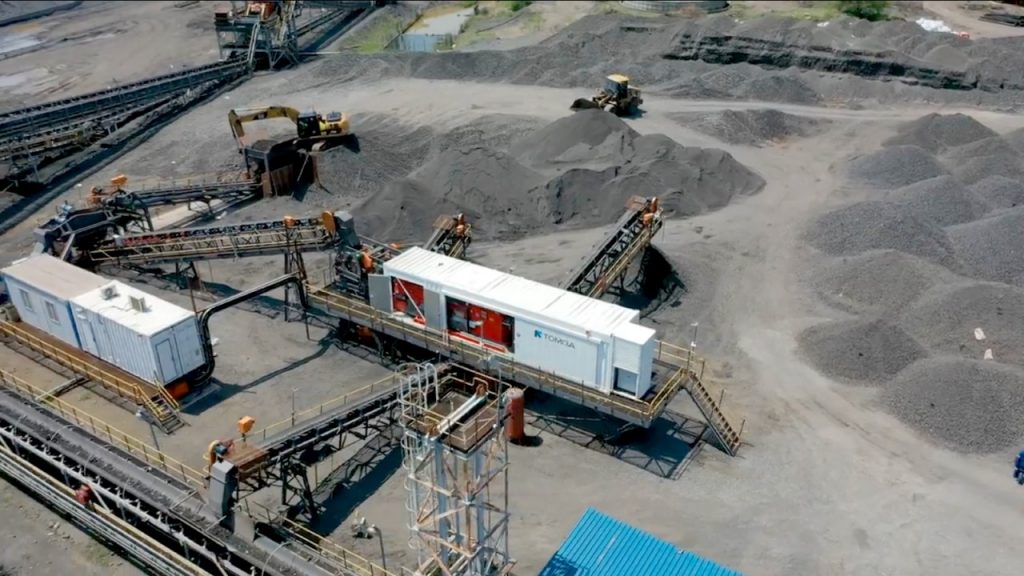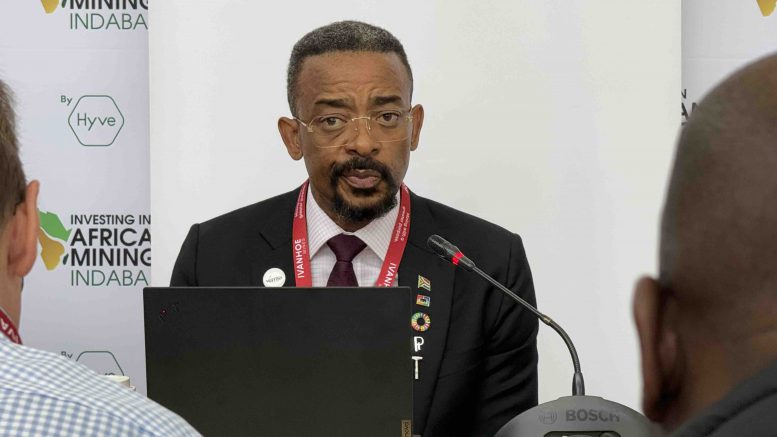[caption id="attachment_1003734337" align="aligncenter" width="550"]
 Sorting plant Credit: Tomra
Sorting plant Credit: Tomra[/caption]
SOUTH AFRICA – With a rise in chrome demand driven by China’s stainless steel industry, South Africa, the world’s leading producer of chrome and ferrochrome, is struggling with rising costs at its operations as larger-scale mines are developed. These larger operations are less selective and produce marginal lower-grade material due to dilution of the orebody, which in turn increases costs as traditional methods of separating the low-chromite material are resource and power-intensive.
Tomra’s X-ray transmission (XRT) sensor-based ore sorting is an established technology with physical separation. It features a simple, low-cost process with high productivity and a low environmental impact.
The associated X-ray sensor accurately establishes the density of each particle in the feed and high-speed pneumatic ejectors separate ore with high chromite content from low-grade material at rates between 60 tonnes per hour to 200 tonnes per hour through a dry, low-energy process. The resulting high-grade product is ready to sell.
Tomra’s XRT technology exceeds expectations at LG6 mine
P2E Consulting, an engineering and project management company, turned to Tomra looking for a solution to improve the efficiency of the sorting plant at the LG6 mine. The consultancy commissioned a Tomra Com XRT 2.0 sorter to replace an existing drum dense media separation (DMS) plant.
“The mine used the DMS plant to produce saleable small lumpy product from the mine’s LG6 chromite ROM (run of mine) and dumps at a minimum grade of 38%, but it was very inefficient,” Craig Meadway, business development executive of P2E Consulting, explained in a release. “The Tomra XRT sorter has resolved this issue. It is used to upgrade under value (UV) material with a head grade of 20% to 28%, to produce a saleable product at a minimum grade of 38% Cr2O3. It does this efficiently and at a low cost of production.”
The sorter performance has exceeded expectations, achieving grades in excess of 40% Cr2O3 and mass recoveries of 25% to 30% from scalped waste.
“No other technology has given us such a high recovery rate. Not only that, with Tomra’s XRT, there was no water usage at all and we didn’t need to spend on expensive reagents, so that we are producing small lumpy product for approximately 50% of the cost compared to a DMS plant,” Meadway added.
The environmental benefits of Tomra’s XRT solution played a factor in P2E’s choice of technology: “We are looking to introduce greener technologies into the mining industry. The fact that no water or chemicals are used is a major advantage,” Meadway concluded.
Easy operations with support from Tomra
The straightforward operations of Tomra’s XRT sorters are a further advantage for operators. In addition, the company’s support offering also played a factor in P2E’s choice of supplier.
Tomra Sorting Mining designs and manufactures sensor-based sorting technologies for the mineral processing and mining industries.
For more information, visit
www.Tomra.com.

 Sorting plant Credit: Tomra[/caption]
SOUTH AFRICA – With a rise in chrome demand driven by China’s stainless steel industry, South Africa, the world’s leading producer of chrome and ferrochrome, is struggling with rising costs at its operations as larger-scale mines are developed. These larger operations are less selective and produce marginal lower-grade material due to dilution of the orebody, which in turn increases costs as traditional methods of separating the low-chromite material are resource and power-intensive.
Tomra’s X-ray transmission (XRT) sensor-based ore sorting is an established technology with physical separation. It features a simple, low-cost process with high productivity and a low environmental impact.
The associated X-ray sensor accurately establishes the density of each particle in the feed and high-speed pneumatic ejectors separate ore with high chromite content from low-grade material at rates between 60 tonnes per hour to 200 tonnes per hour through a dry, low-energy process. The resulting high-grade product is ready to sell.
Tomra’s XRT technology exceeds expectations at LG6 mine
P2E Consulting, an engineering and project management company, turned to Tomra looking for a solution to improve the efficiency of the sorting plant at the LG6 mine. The consultancy commissioned a Tomra Com XRT 2.0 sorter to replace an existing drum dense media separation (DMS) plant.
“The mine used the DMS plant to produce saleable small lumpy product from the mine’s LG6 chromite ROM (run of mine) and dumps at a minimum grade of 38%, but it was very inefficient,” Craig Meadway, business development executive of P2E Consulting, explained in a release. “The Tomra XRT sorter has resolved this issue. It is used to upgrade under value (UV) material with a head grade of 20% to 28%, to produce a saleable product at a minimum grade of 38% Cr2O3. It does this efficiently and at a low cost of production.”
The sorter performance has exceeded expectations, achieving grades in excess of 40% Cr2O3 and mass recoveries of 25% to 30% from scalped waste.
“No other technology has given us such a high recovery rate. Not only that, with Tomra’s XRT, there was no water usage at all and we didn’t need to spend on expensive reagents, so that we are producing small lumpy product for approximately 50% of the cost compared to a DMS plant,” Meadway added.
The environmental benefits of Tomra’s XRT solution played a factor in P2E’s choice of technology: “We are looking to introduce greener technologies into the mining industry. The fact that no water or chemicals are used is a major advantage,” Meadway concluded.
Easy operations with support from Tomra
The straightforward operations of Tomra’s XRT sorters are a further advantage for operators. In addition, the company’s support offering also played a factor in P2E’s choice of supplier.
Tomra Sorting Mining designs and manufactures sensor-based sorting technologies for the mineral processing and mining industries.
For more information, visit
Sorting plant Credit: Tomra[/caption]
SOUTH AFRICA – With a rise in chrome demand driven by China’s stainless steel industry, South Africa, the world’s leading producer of chrome and ferrochrome, is struggling with rising costs at its operations as larger-scale mines are developed. These larger operations are less selective and produce marginal lower-grade material due to dilution of the orebody, which in turn increases costs as traditional methods of separating the low-chromite material are resource and power-intensive.
Tomra’s X-ray transmission (XRT) sensor-based ore sorting is an established technology with physical separation. It features a simple, low-cost process with high productivity and a low environmental impact.
The associated X-ray sensor accurately establishes the density of each particle in the feed and high-speed pneumatic ejectors separate ore with high chromite content from low-grade material at rates between 60 tonnes per hour to 200 tonnes per hour through a dry, low-energy process. The resulting high-grade product is ready to sell.
Tomra’s XRT technology exceeds expectations at LG6 mine
P2E Consulting, an engineering and project management company, turned to Tomra looking for a solution to improve the efficiency of the sorting plant at the LG6 mine. The consultancy commissioned a Tomra Com XRT 2.0 sorter to replace an existing drum dense media separation (DMS) plant.
“The mine used the DMS plant to produce saleable small lumpy product from the mine’s LG6 chromite ROM (run of mine) and dumps at a minimum grade of 38%, but it was very inefficient,” Craig Meadway, business development executive of P2E Consulting, explained in a release. “The Tomra XRT sorter has resolved this issue. It is used to upgrade under value (UV) material with a head grade of 20% to 28%, to produce a saleable product at a minimum grade of 38% Cr2O3. It does this efficiently and at a low cost of production.”
The sorter performance has exceeded expectations, achieving grades in excess of 40% Cr2O3 and mass recoveries of 25% to 30% from scalped waste.
“No other technology has given us such a high recovery rate. Not only that, with Tomra’s XRT, there was no water usage at all and we didn’t need to spend on expensive reagents, so that we are producing small lumpy product for approximately 50% of the cost compared to a DMS plant,” Meadway added.
The environmental benefits of Tomra’s XRT solution played a factor in P2E’s choice of technology: “We are looking to introduce greener technologies into the mining industry. The fact that no water or chemicals are used is a major advantage,” Meadway concluded.
Easy operations with support from Tomra
The straightforward operations of Tomra’s XRT sorters are a further advantage for operators. In addition, the company’s support offering also played a factor in P2E’s choice of supplier.
Tomra Sorting Mining designs and manufactures sensor-based sorting technologies for the mineral processing and mining industries.
For more information, visit 




Comments